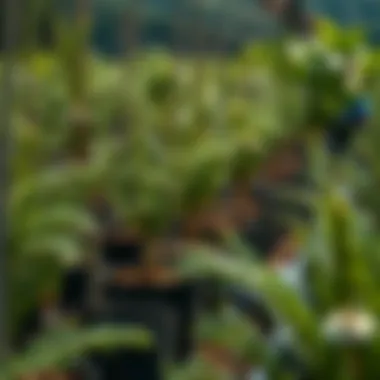In-Depth Study of Cypress Seeds and Their Significance


Intro
Cypress seeds are often overlooked in the grand scheme of horticultural studies, yet they hold a treasure trove of potential for both ecological health and agricultural practices. These small yet robust seeds are life’s blueprint for one of nature’s most enduring trees—Cypress. Their biological characteristics are fascinating. Each seed encapsulates the genetic information that can give rise to a towering tree, friendly to both wildlife and humans alike. Understanding the nature of these seeds can unlock doors to not just preservation but also practical applications in forestry and gardening.
The significance of cypress seeds stretches far beyond simple propagation. They play pivotal roles in maintaining ecosystems, aiding in erosion control, and providing habitats for various species. Notably, the cypress tree itself offers resistance against pests and what some might call an ironclad defense against climatic extremes, showcasing why the seeds are essential. It is a cyclical dance of nurturing the earth, engaging farmers and enthusiasts alike, aiming for sustainability that can withstand the test of time.
In the following sections, we'll unpack the layers surrounding these seeds—from their biological traits to their cultivation methods. By shedding light on sustainable practices and essential tools, this exploration seeks to bridge the gap between mere information and actionable insight, serving both the professional and novice in the field of horticulture. With this guide, a deeper understanding of cypress seeds will emerge, showcasing their remarkable role in the natural world.
Foreword to Cypress Seeds
Cypress seeds, often overlooked in discussions about forestry and horticulture, are pivotal to the life cycle of these magnificent trees. Understanding cypress seeds is crucial for anyone looking into sustainable practices, conservation efforts, or simply trying to appreciate the natural beauty these trees contribute to our environment. They represent the beginning of life for the cypress trees, which are instrumental in maintaining ecological balance and promoting biodiversity.
The significance of cypress seeds extends beyond just their role in reproduction. These seeds are known for their hardiness, able to withstand variations in climate and soil conditions. This resilience not only facilitates their spread in diverse habitats but also stands as a model for adaptive growth strategies in the face of environmental changes.
"Seeds are but the beginning of a long journey, a journey that speaks volumes about resilience, adaptability, and life itself."
Moreover, their biological characteristics and germination requirements offer fascinating insights into the environmental conditions necessary for thriving ecosystems. These aspects not only highlight their relevance in natural settings but also guide the methodologies adopted by agriculture farmers and enthusiasts in cypress cultivation.
When discussing the importance of cypress seeds, one must also consider their ecological significance. They support wildlife, improve air quality, and stabilize soil, thus playing multiple roles in our ecosystem. As such, they are not merely a means of reproduction; they are foundational elements in the fight against climate change and habitat loss. Recognizing this broader implication sets the stage for a deeper exploration into the characteristics, types, and challenges associated with cypress seeds and their cultivation.
Biological Characteristics of Cypress Seeds
Understanding the biological characteristics of cypress seeds is key to unlocking their full potential in both conservation and cultivation. Cypress seeds are not just tiny structures; they embody the future of many ecosystems. By examining their structure and composition as well as germination requirements, we gain insights that are crucial for anyone engaged in agriculture or horticulture.
Seed Structure and Composition
Cypress seeds exhibit a unique structure that reflects their adaptability in diverse environments. Generally, these seeds are small, ranging from about 3 to 8 millimeters in length, often resembling tiny ovals. Their outer layer, or seed coat, is typically hard and woody. This toughness protects the inner tissue from adverse weather and pest damage, allowing seeds to survive longer periods before germination.
Inside, you'll find essential components vital for growth. The seed contains an embryo, which will develop into a new tree, as well as a starchy endosperm that provides energy during the initial stages of growth. The nutrient composition varies among species, notably influencing the seed's viability and germination rate. For instance, seeds from the Taxodium distichum species are noted for their higher oil content, necessitating specific management during propagation.
It's important to note that the conditions surrounding the seeds, such as soil quality and moisture levels, can significantly impact their structural integrity and growth potential.
When engaging with cypress seeds, understanding their structure allows farmers and horticulturists to anticipate how to manage them effectively, ensuring robust growth post-germination.
Germination Requirements
Cypress seeds have specific germination requirements that must be adhered to for successful establishment. Firstly, these seeds generally prefer well-drained soil that includes a mix of sand and loam. This combination offers the aeration needed for seedling roots to develop. Additionally, they thrive under slightly acidic conditions, with a pH between 5.5 to 6.5 proving ideal.
Moisture is another critical factor. Seeds typically require consistent moisture levels, especially during their initial germination period. Over-saturation can lead to rot, while inadequate moisture can cause the seeds to dry up before they have a chance to sprout. A good practice is to ensure that the upper layer of soil remains warm and moist, as this can significantly improve germination rates.
Light conditions also play a role. While some species may germinate in full sun, others might prefer partial shade. Understanding the specific light preferences for the type of cypress will assist in planning their cultivation in gardens or nurseries.
Here’s a brief overview of the key germination conditions for cypress seeds:
- Soil Type: Well-drained, loamy soil
- pH Level: 5.5 to 6.5 for optimal acidity
- Moisture: Consistent moisture without waterlogging
- Light Conditions: Varies by species, generally from partial shade to full sun
Types of Cypress Seeds


Understanding the types of cypress seeds is fundamental for anyone involved in gardening, landscaping, or forestry. Each type represents a unique set of characteristics that can influence growth patterns, habitat adaptations, and overall health. Not only do these seeds play a key role in ecological sustainability, but they also have practical implications in various applications, from aesthetics to timber production. This section will examine prominent varieties of cypress and their geographical distribution, allowing practitioners to make informed decisions about which types to cultivate in specific environments.
Prominent Varieties of Cypress
Cypress trees are not just one species but a rich genus with diversity that catches the eye. Some widely recognized varieties include:
- Bald Cypress (Taxodium distichum): This tree thrives in wetland conditions and is identifiable by its distinctive knobby knees. The seeds are small, round, and generally spread by water.
- Montezuma Cypress (Taxodium mucronatum): Known for its impressive trunk size and longevity, this variety also produces seeds that are engineered for dispersal by water, similarly to its bald cousin.
- Leyland Cypress (× Cupressocyparis leylandii): A hybrid of two other cypress species, this tree is favored in landscaping due to its rapid growth and dense foliage. Its seeds are lightweight, allowing for wind dispersal.
- Italian Cypress (Cupressus sempervirens): Often associated with Mediterranean landscapes, its seeds require dry conditions for optimal germination, setting it apart.
Each of these varieties offers distinct advantages. For instance, Bald Cypress can manage flooded conditions, making it an excellent candidate for wetlands restoration. In contrast, Leyland Cypress can serve as a robust screen, growing quickly to provide privacy. The choice of which cypress seed to cultivate hinges on the environment and intended use.
Geographical Distribution of Species
Cypress trees hold a significant place across various regions, from North America to the Mediterranean, each variety adapted to its local environment. Understanding where these species thrive is crucial for appropriate planting:
- Bald Cypress: Predominantly found in the southern United States, this tree flourishes in swampy areas ranging from Texas to Florida. Its adaptability to wet conditions allows it to grow in environments where few others survive.
- Montezuma Cypress: Found mainly in Mexico, this tree is a critical component of its native forests and is resilient to varying moisture levels.
- Leyland Cypress: This hybrid is cultivated increasingly in the UK and the U.S. for hedges and windbreaks. Its rapid growth makes it a popular choice in regions with ample rainfall.
- Italian Cypress: Native to the Mediterranean basin, it thrives in dry, rocky soil, frequently seen in gardens and landscaping designs where drought resistance is an asset.
The geographical distribution informs not only the potential for cultivation but also considerations for conservation. Understanding which species to plant in which regions can enhance ecosystem stability and biodiversity.
"Choosing the right type of cypress seed is not only about aesthetics; it directly impacts the environment, requiring a thoughtful approach to horticulture and forestry."
Cypress seeds have far-reaching implications in cultivation and conservation, making knowledge of their types essential for any serious agricultural practitioner.
Cultivation Techniques
Cultivating cypress seeds may harness the very essence of nature's cycle. This section unpacks the techniques that can maximize the success of cypress seed propagation, emphasizing that not all methods might fit every circumstance. Understanding these techniques provides a clearer path toward ensuring healthy growth and robust ecosystems.
Propagation Methods
Direct Seeding
When it comes to direct seeding, the straightforwardness is hard to miss. It involves placing the seeds right into the soil where they are meant to grow, a method that resonates well with many growers. Direct seeding is a beneficial approach often preferred for it minimizes the stress seedlings might endure during transplantation. The seeds undergo germination in their permanent locations, allowing them to acclimate naturally to local soil and climate conditions.
A key characteristic of direct seeding lies in its cost-effectiveness. Unlike transplanting seedlings, there’s no necessity for pots or starter trays, which not only saves on materials but also significantly reduces labor. The unique feature here is that it allows for a higher density of the plants; however, it depends on the soil temperature and moisture levels, which should be taken seriously. Scores of cypress species, especially the more amenable ones, thrive under this method, easing the worries of growers.
Yet, it’s vital to consider some potential downsides. Direct seeding can attract pests more readily when seeds are left exposed. Additionally, if a drought occurs following planting, seed viability decreases sharply. So, while it holds appeal, direct seeding does require suitable timing and attention to environmental conditions.
Transplanting Seedlings
Transplanting seedlings is another solid choice that speaks to many growers aiming for better control over plant health and formation. This method involves nurturing seedlings in a controlled environment before moving them to their final locations. One of the essential advantages of transplanting seedlings is that it allows growers to select the fittest seedlings, leading to a resilient stand.
This method’s key characteristic deserves mention: it provides an opportunity to optimize early growth conditions. Seedlings can be watered, fertilized, and monitored for pests before being transferred. The unique feature of this approach is that it promotes stronger root systems, as seedlings can build up sufficient biomass before knee-deep in the elements literally.
However, transplanting comes with its share of challenges. Handling delicately during transplant can be tricky, as any root disturbance can shock the plants. Additionally, one might need to harden off seedlings to prepare them for their new surroundings, a process that may take time. Thus, while transplanting seedlings can indeed be beneficial, it is not foolproof and demands diligence from the grower’s side.
Soil and Environmental Considerations
Soil health is paramount when considering cypress cultivation. Natural habitats of cypress species indicate that they favor well-drained, sandy soils, though some can tolerate more varied conditions. Growers should conduct soil tests to gauge pH levels and nutrient content. Adjusting the soil mixture with organic matter can create a balanced environment conducive to germination and growth. Besides soil types, environmental factors like light availability and competition from other flora must be monitored.
A suitable environment for cypress growth is an ecosystem of mutual support—while the trees grow, they also lend a hand to the soil and fellow flora around them.


Watering and Fertilization Practices
Watering strategies should adapt the cypress’s natural habitat. A deep watering technique—though sporadic—encourages deeper root growth, anchoring the seedlings firmly. Care should also be taken not to overwater, as cypress seeds often accompany higher chances of rot in soggy conditions.
Furthermore, fertilization practices can immensely affect growth rates. A slow-release fertilizer can provide essential nutrients over time, keeping young trees robust. However, timing is crucial here, too. Fertilizers should be applied in accordance with growth stages to avoid nutrient burn. Likewise, it’s best to follow up with regular monitoring of plant health, adjusting water and nutrition as needed.
With the right methods and considerations at hand, cultivating cypress seeds can evolve from mere planting efforts into a rewarding horticultural endeavor, benefiting both the environment and the grower alike.
Challenges in Cypress Seed Propagation
The journey of propagating cypress seeds is wrought with challenges that can thwart even the most diligent horticulturists. Understanding these obstacles is pivotal because they dictate not only the success rate of cultivation but also the overall health of cypress ecosystems. From unwelcome pests to fluctuating climate conditions, the ability to navigate these hurdles can greatly enhance the effectiveness of cypress planting initiatives.
One of the predominant focal points in the propagation process is the management of pests and diseases. Cypress trees, while hardy in many aspects, aren't immune to the ravages of nature. For instance, insects like the cypress bark beetle can wreak havoc on seedlings, leading to reduced survival rates. These pests tend to thrive in conditions where the tree is already stressed, such as during periods of drought or after a major environmental disruption.
"Effective pest management often requires a mix of approaches, targeting both prevention and intervention strategies."
Pest and Disease Management
To mitigate threats to cypress seedlings, integrated pest management (IPM) techniques come into play. This comprehensive strategy combines various methods:
- Cultural practices: Keeping the planting area clean and reducing debris can limit pest populations.
- Biological control: Introducing natural predators or parasites of the pests can check infestations without chemical intervention.
- Chemical solutions: In severe cases, using targeted pesticides can be necessary, but it’s crucial to choose options that have minimal impact on beneficial organisms in the ecosystem. The timing and application methods greatly influence the effectiveness and safety of chemical pest control.
Furthermore, monitoring for early signs of disease like cypress canker is essential. The realization that a tree is compromised can dictate immediate actions to save the grove or find a cure.
Climate and Environmental Impacts
Another layer of complexity in cypress propagation is the impact of climate and environmental conditions. Cypress seeds require precise conditions to germinate and grow into vigorous seedlings. Factors such as temperature, humidity, and soil type all play a significant role.
For example, cypress germination rates can plummet if seeds are exposed to prolonged cold spells or extreme heat. These trees typically thrive in regions with moderate climates; thus, sudden climatic shifts due to climate change can adversely affect their survival.
- Increased rainfall can lead to oversaturation, while extended droughts can hinder growth and seedling health.
- Wildfires, often exacerbated by climate variations, pose another threat. While some cypress varieties are resilient to fire, young seedlings may not survive such extreme conditions.
Careful attention to these aspects can help in developing strategies that enhance growth potential. This includes understanding the optimal times for planting relative to local weather patterns, using mulch to stabilize soil moisture, and selecting disease-resistant varieties suited to the local environment.
By addressing these challenges head-on, horticulturists can enhance tree health and promote sustainability in cypress seed propagation. Building a foundation of knowledge not only benefits individual planting efforts but also supports larger conservation initiatives aimed at preserving these majestic trees.
Cypress Seeds in Horticulture and Forestry
Cypress seeds hold a pivotal spot in both horticulture and forestry. Their use transcends mere aesthetic appeal; they contribute significantly to ecological balance and sustainable practices. When planned correctly, the incorporation of cypress varieties into landscapes can enhance biodiversity, provide habitats, and improve air quality. They are particularly valued for their adaptability to varying soil types and conditions, which makes them suitable for a range of landscapes—from urban settings to natural reserves.
Landscape and Aesthetic Applications
Cypress trees are often praised for their visual appeal and functional properties in landscaping. Their distinctive shapes and lush greenery can elevate any landscape design. Here are some notable benefits of using cypress seeds for aesthetic applications:
- Diversity in Design: The different species of cypress offer a variety of colors and forms. For instance, the Bald Cypress can add a unique silhouette with its distinctive knee-like roots surfacing above ground.
- Privacy Screen: Many cypress varieties grow tall and densely, which makes them ideal for creating natural barriers. They can be effectively used as hedgerows or windbreaks, fostering both seclusion and security in gardens.
- Resilience in Tough Conditions: Cypress trees can thrive in waterside locations and withstand periodic flooding. This resilience allows them to be utilized in landscapes that might challenge less hardy plants.
"Using cypress in landscape design is like providing nature with a functional brush that paints beauty while protecting the ecology."


The incorporation of cypress into community parks and nature reserves also offers aesthetic enjoyment alongside functional benefits. When planted in clusters, they can create serene and calming environments, attracting visitors while supporting local wildlife.
Conservation Efforts with Cypress
Cypress seeds serve a crucial role in conservation efforts, especially given the declining habitats faced by many species today. Several aspects accentuate their importance:
- Habitat Restoration: Various cypress species are integral to wetlands, playing a part in reintroducing native flora and fauna to native environments. Their planting is essential when rehabilitating ecosystems that have faced degradation due to urban development or climate impacts.
- Biodiversity Support: These trees provide a habitat for diverse wildlife, from birds seeking refuge to aquatic organisms benefiting from nutrient-rich environments created by fallen leaves and debris. This symbiotic relationship highlights the need for conscious propagation and planting of cypress seeds.
- Climate Change Mitigation: By absorbing carbon dioxide, cypress trees contribute to climate change mitigation. Their growth and conservation are part of broader strategies aimed at reducing the carbon footprint of urbanized areas.
- Community Engagement: Planting cypress in community spaces fosters awareness and participation in ecological practices among residents. Outreach and education about the benefits of cypress contribute to stronger conservation mindsets in communities.
Future Prospects and Innovations
The world of cypress seeds is on the brink of exciting transformations driven by advancements in genetic research and sustainable practices. As we face increasing environmental pressures, the exploration of future prospects surrounding cypress seeds not only holds significant implications for conservation but also paves the way for innovative applications in forestry and horticulture.
Genetic Research in Cypress Species
Genetic research in cypress species is crucial in understanding and enhancing the resilience of these trees. By delving into the genetic makeup, we can:
- Identify traits linked to disease resistance.
- Enhance growth rates and adaptability to various climates.
- Select strains that are more efficient in carbon sequestration.
For instance, researchers have begun to sequence the genomes of specific cypress varieties. This information can be a game-changer in developing hybrids that are not only robust but also tailored to thrive in changing conditions. In an era where climate variations are increasingly unpredictable, such advancements can offer alternatives that can withstand pests, diseases, and extreme weather.
"Understanding the genetics of cypress species is like holding a key to an ecosystem that balances both beauty and function."
Moreover, genetic tools allow for marker-assisted selection, streamlining the breeding process. This technology could fast-track the development of seedlings that are inherently more resilient. For those immersed in forestry or horticulture, this means a future where cypress tree plantations could thrive for generations.
Sustainability and Climate Resilience
The need for sustainability is undeniable, especially for practices involving cypress seeds. As custodians of our environment, it's critical to marry conservation goals with practical uses. Sustainable practices in cypress cultivation can take various forms:
- Responsible harvesting: Using methods that ensure long-term viability of cypress populations.
- Reforestation initiatives: Planting cypress in native habitats where they can restore balance.
- Educating communities: Making farmers and landowners aware of the benefits of cypress trees, not just for aesthetics but also for their ecological services.
Cypress trees are known for their ability to mitigate climate change due to their substantial biomass. Maintenance of healthy cypress ecosystems contributes to:
- Improved biodiversity.
- Enhanced water quality by filtering pollutants.
- Carbon capture through photosynthesis.
As we explore sustainable practices, the emphasis must be placed on cultivating cypress seeds in a way that balances both environmental and economic benefits. Techniques such as agroforestry provide an integrated approach, allowing farmers to grow cypress alongside crops, thus maximizing land utility while fostering ecological health.
Finale
The conclusion of this comprehensive guide helps crystallize the crucial points discussed throughout the article about cypress seeds and their multifaceted roles in agriculture, ecology, and conservation. By reflecting on the various aspects surrounding these seeds, we can better appreciate their importance not just in propagation but also in maintaining healthy ecosystems and enhancing our landscapes.
Summary of Key Insights
Throughout this article, we've explored a wealth of information related to cypress seeds, highlighting the following key insights:
- Biological Characteristics: Cypress seeds have unique structures and characteristics that make them well-suited to specific environmental conditions, showcasing their adaptability and resilience.
- Ecological Importance: The ecological significance of these seeds cannot be overstated; they play vital roles in carbon sequestration, habitat provision, and supporting biodiversity. Their survival ensures the continuity of entire ecosystems.
- Cultivation Techniques: Addressing the various propagation methods, from direct seeding to nurturing seedlings, offers practical guidelines for effective cypress cultivation.
- Challenges: Challenges like pest management and the changing climate demand attention and innovation from farmers and conservationists, ensuring a sustainable future for cypress species.
- Future Prospects: The ongoing research into genetic variations and environmental adaptation emphasizes the need for proactive measures to maintain these species as we face climate change.
The future of cypress seeds is intimately tied to our actions today, calling for a concerted effort toward sustainable practices.
Call to Action for Sustainable Practices
As we conclude this exploration of cypress seeds, it’s imperative to consider what lies ahead. Farmers and enthusiasts alike must adopt sustainable practices that foster growth and biodiversity while protecting against the challenges posed by environmental changes. Here are some practical steps:
- Embrace Education: Stay informed about the latest research and advancements in cypress cultivation. Utilize resources from agricultural universities and government studies to refine your methods.
- Collaborate: Join forces with local conservation groups, agricultural societies, and environmental organizations. Share knowledge and resources to enhance community efforts toward sustainable farming.
- Innovate: Experiment with new techniques and technologies in seed propagation and pest management. Look into sustainable pest deterrents and soil enrichment practices that promote healthy growth.
- Advocate: Be a voice for environmental conservation in your community. Promote policies that encourage the protection of cypress habitats and biodiversity.
In summary, the fate of cypress seeds lies in our hands. By working together and implementing sustainable practices, we can ensure the continued health and proliferation of these remarkable species, paving the way for future generations to appreciate their value.







